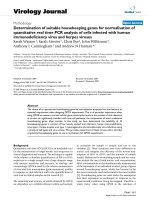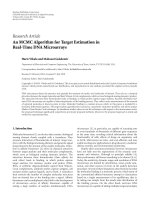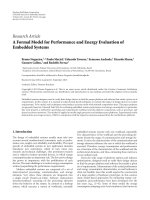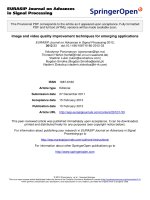Dynamic scheduling techniques for adaptive applications on real time embedded systems
Bạn đang xem bản rút gọn của tài liệu. Xem và tải ngay bản đầy đủ của tài liệu tại đây (1.2 MB, 141 trang )
Dynamic Scheduling Techniques for Adaptive
Applications on Real-Time Embedded Systems
Yu Heng
(B.Eng, National University of Singapore, Singapore, 2006)
A THESIS SUBMITTED IN PARTIAL FULFILLMENT OF THE
REQUIREMENTS FOR THE DEGREE OF DOCTOR OF PHILOSOPHY
DEPARTMENT OF ELECTRICAL AND COMPUTER ENGINEERING
NATIONAL UNIVERSITY OF SINGAPORE
2011Acknowledgements
This thesis would not have the opportunity to progress and present itself, without
the enduring guidance, cooperation, accompany, and encourage from my super-
visors, colleagues, and my family. I wish I could express my gratitude to all of
them.
First of all, I would like to sincerely thank my supervisors, Prof. Ha Yajun
and Prof. Bharadwaj Veeravalli, for all their devoted supports during my doctoral
studies. I am grateful that they opened my door to the scientific exploration, that
they provided timely and valuable advices whenever there are obstacles ahead, and
that they enlightened me with their insights of life the way a role model does. I
will not forget the time that they arrived before sunrise to help me with the paper
revise before its submission. I could be no luckier to have both of my supervisors
as they are.
I would like to acknowledge the help from Dr. Zhu Guolei and Dr. Akash
Kumar for the discussions with key concepts in the NoC related work. I would
have no more gratitude to Dr. Wei Ying for introducing me to the Latex world
and encouragement during the hard time.
I appreciate the support from the smiling ladies in the Electronic Design Labs
on my GA duties, as well as the mutual assistance from Zhang Wenjuan, Chen
i
ACKNOWLEDGEMENTS
Xiaolei, and Ganesh Iyer.
I am lucky to spend my best time in the VLSI Laboratory with all my fellow
mates, for the fun and memory.
I have no way to express the love to my parents. They are where warmth and
encouragement originate from. To them, this thesis is dedicated.
ii
Abstract
The ability to trade off Quality-of-Service (QoS) with resources on modern em-
bedded platforms makes adaptive applications an interesting value proposition.
Applying dynamic scheduling for such applications will bring further flexibility
for meeting the overall system’s performance goals. However, the state-of-the-art
dynamic scheduling strategies, in general, either are incapable of QoS optimiza-
tions, or ignore the increasing platform-introduced impacts that may substantially
deteriorate the scheduling performance.
This thesis focuses on the design of dynamic scheduling algorithms for adaptive
applications, with the goal of maximizing QoS based on the runtime slack reclama-
tion and re-distribution. For the QoS modeling, both the Imprecise-Computation
(IC) model [1] and a proposed generic model, are validated and studied. The al-
gorithms are built upon increasingly complicated assumptions, namely scheduling
(1) IC-modeled tasks on uni-processor systems, (2) dependent IC-modeled tasks
on homogeneous multiprocessors, and (3) a generic QoS model on heterogeneous
multiprocessors considering the leakage energy and QoS deterioration due to inter-
processor communications.
First, a dynamic algorithm for scheduling IC tasks mapped on a single pro-
cessor is presented. We prove that the QoS maximization can be achieved by
iii
SUMMARY
employing the intra-task Dynamic Voltage Scaling (DVS). The derived theorem
leads to the convenient selection of a slack receiver, by comparing the QoS gradi-
ents of the IC-modeled receivers. A Gradient Curve Shifting (GCS) approach is
proposed to make the theorem applicable to both linear and concave QoS models.
Second, we extend to scheduling IC tasks on homogeneous multiprocessors.
Although it is possible to apply the uni-processor algorithm to dedicate the whole
slack to only one receiver, we consider all parallel receivers in multiprocessors, and
optimally derive the slack distribution strategy that outperforms the uniprocessor-
based algorithm. Beyond that, a heuristic slack receiver selection strategy is pre-
sented to select the best receiver set that potentially produces the maximal QoS.
Third, we extend the idealized IC model by proposing a more practical generic
QoS model, and present a dynamic scheduling algorithm targeting heterogeneous
multiprocessors, where each processor has its individual frequency and energy char-
acteristics. We propose a Guided-Search algorithm that efficiently determines the
receiver execution speed, in order to achieve the QoS maximization for the generic
model. The receiver selection methodology is also novelly designed for the generic
model. Moreover, an enhancement on the scheduling performance by taking care
of slack losses due to inter-processor communications is reported.
Finally, to make our work self-contained, we develop a static scheduling algo-
rithm targeting inter-processor communications on Network-on-Chip (NoC) archi-
tectures. While our dynamic approaches are assumed to adopt any static schedul-
ing results, the proposed method is a unified approach that optimally achieves the
computation element mapping, the communication path decision, and the execu-
tion time scheduling.
We support our proposed algorithms by evaluating the performance of schedul-
iv
SUMMARY
ing numerous synthesized task sets and realistic adaptive applications. The evalu-
ation software, employing cycle-accurate architecture and NoC simulators, is also
introduced in detail.
v
Contents
Acknowledgements i
Abstract iii
Contents vi
List of Figures x
List of Tables xiv
1 Introduction 1
1.1 Motivation 1
1.2 Thesis Contributions . 7
1.3 List of Publications . 10
1.4 OrganizationoftheThesis 11
2 Related Work 12
2.1 Adaptive Applications . 12
2.2 Application Scheduling Techniques . 14
2.2.1 Real-Time Scheduling 14
2.2.2 Energy-Aware Scheduling 15
vi
CONTENTS
2.2.3 Scheduling for Adaptive Applications . 18
2.3 NoC-Aware Scheduling and Mapping . 19
3 System Modeling and Problem Formulation 21
3.1 ArchitecturalandEnergyModel 21
3.2 Application Model . 24
3.3 Problem Definition . 28
4 Scheduling Imprecise Computation Tasks on a Single Processor 31
4.1 Static Scheduling Strategy 32
4.2 DynamicSlackReclamationwithoutDVS 33
4.2.1 Slack allocation for linear QoS functions 33
4.2.2 SlackallocationforconcaveQoSfunctions 36
4.3 Dynamic Slack Reclamation under DVS . 38
4.3.1 Deciding maximal optional cycles . 39
4.3.2 Allottingoptionalcycles 41
4.4 ResultsandDiscussion 42
5 Scheduling Imprecise Computation Tasks on Multiprocessors 46
5.1 Motivational Example . 48
5.2 Slack Distribution Optimality Analysis . 50
5.3 Slack Receiver Selection 53
5.3.1 Task grouping . 53
5.3.2 Receiver selections in FCS and PCS 55
5.3.3 Online distribution 57
5.4 ResultsandDiscussion 60
vii
CONTENTS
6 Scheduling Generic Models on Multiprocessors with Realistic Con-
siderations 64
6.1 Motivational Example . 65
6.2 Slack Distribution with Frequency Scaling . 68
6.2.1 Optimization . 68
6.2.2 Guided-Search heuristic 70
6.3 Slack Receiver Selection 74
6.3.1 Graphdecomposition 76
6.3.2 Receiver selection from FCS 78
6.3.3 Receiver selection from PCS 79
6.3.4 Runtime receiver selection 81
6.3.5 Implication to static scheduling . 83
6.4 Slack Distribution Considering Inter-Processor Communication . . . 84
6.5 ResultsandDiscussion 87
6.5.1 Setups 88
6.5.2 Synthesizedtasksimulation 89
6.5.3 The JPEG2000 decoder 90
6.5.4 Considering communication variation . 91
7 Supplement: A Communication-Aware Static Scheduling Approach 99
7.1 Preliminaries . 100
7.2 Algorithm Description . 103
7.3 ResultsandDiscussion 107
8 Conclusions and Future Work 113
viii
CONTENTS
Bibliography 117
ix
List of Figures
1.1 A JPEG2000 decoded image using (a) resolution = 3; (b) resolution
=1. 3
1.2 Aircraftpitchperformanceforcontrollertasklevel2and4 4
1.3 Scopeofthethesis 8
3.1 Typical gate leakage behavior of Intel 45nm HK+MG transistors,
compared to 65nm Poly/SiONtransistors[51]. 23
4.1 (a) S within S’. Allocating S to i gives the maximal QoS. (b) Left
shiftingibyScycles 36
4.2 (a) S larger than S’. S cannot be fully allocated to i. (b) shifting i
by S’ so that curves i’ and j intercept at y-axis. (c) Shifting j by S
j
,
i’ by S
i
,simultaneously. 37
4.3 The Energy−Timespace 41
4.4 NormalizeddynamicQoSvs.no.oftasks. 43
4.5 Effects of no DVS applicable to GCS and optimal solutions. . . . . 44
4.6 Energy and time utilization of the three algorithms. 45
5.1 Framework of multiprocessor dynamic scheduling for IC tasks. . . . 47
x
LIST OF FIGURES
5.2 (a) Illustrative example where
2
distributes slack. (b) Slack distri-
bution results on
4
,whereS is used to generate Δo
4
. Note that all
tasks in (a) are IC-modeled, thus are divided into mandatory and
optional parts, e.g. m
4
and o
4
. For clarity purpose, this is not shown
in (a). 48
5.3 (a) Graph decomposition illustration for
a
. Note that the link
between
d
and
j
is omitted due to precedence redundancy. Same
as
e
and
m
. (b) A task can belong to PCS or FCS of different
slackgenerators. 54
5.4 An example showing runtime slack time uncertainty for PCS, S = τ
s
.57
5.5 QoS increase in percentage compared to static scheduled cycles, with
varied slack factors (SF): (a) SF =0.1, (b) SF =0.5, (c) SF =0.9. 61
5.6 QoS increase percentage vs. number of processors. Number of tasks
= 60, SF =0.6 62
5.7 Algorithm efficiency comparison, Our approach v.s. MLSSR, mea-
suredasthenumberofinstructions 63
6.1 Illustrative example showing DVS effect to increase extra cycles. . . 66
6.2 (a) Task d prevents c from receiving the full slack. (b) b and d
compete for the slack time, while d might have more residual cycles. 75
6.3 (a) Total slack time is 110 since
a
blocks
c
and
d
. (b) Total slack
time gained is 150. . 75
xi
LIST OF FIGURES
6.4 (a) Graph decomposition illustration for
a
. Note that the link
between
d
and
j
is omitted due to precedence redundancy. Same
as
e
and
m
. (b) A task can belong to PCS or FCS of different
slackgenerators. 77
6.5 (a) The FCS that fully adopts τ
s
. (b) The resulted graph after
transformation: all precedence tasks are connected. (c) A coloring
example that minimally uses three colors to identify the grouping of
tasks 80
6.6 The slack received for PCS tasks depends on the online execution
status. (a) τ
s,e
=0. (b)τ
s,e
=MIN(τ
s
,t
l
) 80
6.7 (a) An FC selection instance by applying graph coloring, with their
runtime residual cycles. (b) The final FC
2
optimized by applying
Algorithm6.4 82
6.8 (a) A static DAG mapping on a 6-processor system in favor of dy-
namic cycle generation. (b) A static mapping creating PCS nodes,
not preferred for dynamic scheduling. . 84
6.9 Theexperimenttoolset. 95
6.10 Normalized cycle gain on (a)8, (b)32, (c)64 processors using three
methods 95
6.11 Scheduler cycles compared with a typical synthesized task. . 96
6.12 Cycle difference between w/ and w/o local scaling, v.s. Gaussian
distribution variances in generating traffic time. 96
6.13 Performance of Algorithm 6.5 under different NoC routing schemes,
on various network size. (a)3×4, (b)4× 6, (c)5×6, (d)6× 6. . . 97
6.14 Efficiency of Algorithm 6.5 compared to the iterative approach. . . 98
xii
LIST OF FIGURES
7.1 A transmission scenario to illustrate the hierarchical definitions.
Γ(Φ(j),φ(i)) = {γ
1
(Φ(j),φ(i)),γ
2
(Φ(j),φ(i))}is the set of two routes
of routing {j
1
,j
2
} to i. The route γ
1
(Φ(j),φ(i)) = {p
1,1
,p
1,2
} is one
way of routing by using path p
1,1
to connect φ(j
1
)andφ(i), while us-
ing path p
1,2
to connect φ(j
2
)andφ(i). γ
2
(Φ(j),φ(i)) = {p
2,1
,p
2,2
}
represents another route. Each path p
x,y
from φ(j
α=1or2
)toφ(i)
consists of two links. . 102
7.2 Simulation results of averaged makespan on the three applications
by applying the three algorithms. 109
7.3 Simulation results of average transmission time on a 3×3 mesh using
3 algorithms on 3 applications. 111
xiii
List of Tables
1.1 QoS levels and timing requirements for Controller. P = primary,S
= secondary 3
3.1 Frequency and energy-per-cycle relationship. . 24
5.1 Task attributes in Fig. 5.2: static scheduled time, immediate parent
nodes, and k
i
49
6.1 List of frequencies and the corresponding energy-per-cycle . 66
6.2 Frequency and energy-per-cycle relationship of the experimental pro-
cessor. 89
6.3 DWTcyclestotransformdifferentlevelsofresolution. 91
6.4 Performance from scheduling a JPEG2000 decoder. 91
7.1 Facts about applications. Critical path is the longest execution path
in the task graph, no transmission delay. Level of parallelism is the
maximumlevelofparallelexecution. 108
xiv
Chapter 1
Introduction
1.1 Motivation
Advancements in silicon processing, IC design, and electronic design automation
(EDA) technologies continuously push the drastic performance improvement of
embedded computing systems. The complexity of applications that an embedded
platform could handle increases as well. Definitions of application execution per-
formance have been extended from “hard” parameters such as memory utilization,
energy consumption, and application response time, to the “soft” behaviors of ap-
plication execution that emphasize on the execution Quality-of-Service (QoS). For
instance, the problem of “at which quality level the video could be rendered to the
viewer” comes under concern once the transmission reliability is ensured.
In view of this, adaptive applications are gaining growing attentions owing
to their capabilities to provide the scalable execution quality in reaction to the
execution environment. Rather than simply completing or failing the execution,
adaptive applications usually define multiple execution granularities such that a
1
CHAPTER 1. Introduction
finer-grained version produces better QoS, at the price of increased program cycles
and energy. This feature makes them promising as real-time embedded applications
provide tunable parameters to cope with the unpredictable execution environment,
by intelligently reducing the service level when the system is overloaded, or boosting
the software performance when system resources are under-utilized.
One of the areas of applying quality adaptation is in multimedia. For example,
the Scalable Video Coding (SVC) scheme in H.264/MPEG-4 AVC standard, is pro-
posed to provide customized QoS to accommodate varying network conditions and
device qualities [2]. Another concrete example is the JPEG2000 codec supporting
multiple playback resolutions [3]. The JPEG2000 decoder allows the reconstruction
of images in a progressive manner. This is possible by the use of Discrete Wavelet
Transform (DWT), which encodes an image into multiple subbands so that a lower
frequency subband contains a finer frequency resolution and a coarser time resolu-
tion. At the decoder, as more data are received, higher resolution images can be
decoded making use of the higher frequency information. Fig. 1.1 illustrates the
effects of image decoding using different resolution settings.
Other than the multimedia applications, Fig. 1.2 and Table 1.1 for example,
excerpted from [4], illustrate the application of an adaptive controller on an Aerial
Combat F-16 flight simulator, as well as the required CPU resources (timing). The
controller is able to command the flight behaviors at two quality levels, with the
primary actuator commands (including elevator, ailerons, rudder, and throttle)
and the secondary set of actuators that further improves the flight performance.
The secondary actuators include the F-16’s afterburner for the extra engine thrust,
as well as wing flaps and a speed brake used to enhance the slow-airspeed control.
From Table 1.1, it is easy to observe the tradeoff between the execution quality
2
CHAPTER 1. Introduction
D E
Fig. 1.1: A JPEG2000 decoded image using (a) resolution = 3; (b) resolution = 1.
Table 1.1: QoS levels and timing requirements for Controller. P = primary,S=secondary.
Level Reward Exec Time (ms) Period (sec) Version
1 100 60 1 P only
2 104 80 1 P+S
3 120 60 0.2 P only
4 124 80 0.2 P+S
and the resource utilization.
State-of-the-art embedded system design methodologies strike to achieve op-
timizations at dual phases: design-time optimization and runtime optimization.
For design-time optimizations, hardware/software co-design strategies are exten-
sively applied that partition functionalities to respective hardware and software
components, synthesize (including mapping and scheduling), and conduct hard-
ware/software co-simulations to iteratively improve the performance. On the other
hand, the runtime optimization strategies achieve, at all abstraction levels, per-
formance enhancements based on the static design and aim at coping with the
3
CHAPTER 1. Introduction
Fig. 1.2: Aircraft pitch performance for controller task level 2 and 4.
execution environment dynamism. In this thesis, we focus on the OS-level runtime
optimization techniques, specifically the design of real-time dynamic scheduling
algorithms for adaptive applications.
Dynamic scheduling algorithms differ from their static counterpart in several
ways. For the static scheduling, task timings and processor frequencies are deter-
mined prior to execution, and the efficiency of the algorithm itself is less of concern.
For the dynamic scheduling, however, the task invocation time and execution speed
are adjusted at the runtime, and the algorithm efficiency is of great importance.
Dynamic task scheduling results in less system idle time and better performance
by exploiting the substantial variation in the actual execution time of tasks. An
important parameter that the dynamic scheduler intakes is the slack time/energy
generated from the precedent tasks [44, 46, 47]. In the context of the adaptive
application scheduling, a slack is re-distributed to its successive tasks to achieve
4
CHAPTER 1. Introduction
further QoS improvements than statically determined, while contemporary energy-
minimization based dynamic schedulers use the slack as the speed slowing down
space.
The design of efficient QoS-aware scheduling algorithms is challenging espe-
cially because it has to meet many simultaneous design requirements and con-
straints. Some of generic, as well as adaptive-specific, considerations in dynamic
scheduling algorithm designs are listed below.
• Other than general purpose OS schedulers that pursue the resources fairness,
real-time schedulers have high temporal requirements. The executional cor-
rectness is not only judged by the computational correctness, but also by the
timeliness of task completion. Carefully deciding task execution order, as
well as the starting time, to avoid deadline violations is in general a primary
goal for real-time schedulers.
• The dynamic algorithm itself, since it is running in the runtime environment,
has to be efficient in terms of the execution time. Established optimization
algorithms such as simulated annealing suffer from the runtime efficiency. Be-
sides the appropriate formulation of the scheduling algorithm, heuristics are
sometimes necessary to tradeoff between the optimization and the efficiency.
• Design of embedded systems, especially battery-supported devices such as
smart phones and wireless sensors, greatly emphasize energy efficiency. In the
last decade, Dynamic Voltage Scaling (DVS) technique has been extensively
studied as the mainstream power reduction strategy for platforms with DVS-
enabled processors. However, scheduling is further complicated by the need
of selecting among multiple execution lengths of the same task under variable
5
CHAPTER 1. Introduction
processor frequencies.
• Due to the fact that embedded systems are usually made to cater specific
applications, the execution time flexibility of adaptive applications introduces
another level of the decision dimension. That is, the task execution time is
not limited to discrete choices depending on available DVS frequencies, but
turns continuous within the range, leading to substantially increased design
complexities and optimization costs.
Besides the intrinsic complexity in adaptive application scheduling algorithm
designs, semiconductor technology trends further complicate the formulation and
solution of the scheduling problems.
• Multiprocessor platforms, usually with the heterogeneity nature, introduce
the thread running concurrency and performance differentiation on distinct
processing components. The scheduling decision space is thus exponentially
extended and optimization costs are drastically increased.
• With semiconductor technology improvements, the device feature size keeps
shrinking, resulting in the significant leakage power that necessitates the com-
bination of both dynamic and leakage energy consumptions into the schedul-
ing framework.
• Inter-processor transmissions as the performance bottleneck for multiproces-
sor systems contribute to a substantial portion of the application makespan.
Without taking specifically into account, transmission time variations could
significantly deteriorate the scheduling performance, thus the quality of ap-
plication execution.
6
CHAPTER 1. Introduction
Given the constrained timing and energy requirements, as well as the flexibil-
ity nature of adaptive applications, determining an optimized and efficient runtime
schedule is in general not easy, and involves trade-off between contradicting opti-
mization objectives. Specifically, traditional DVS techniques can effectively reduce
system energy by scaling down the processor frequency, but it gains no program
quality improvement with unchanged execution cycles. QoS-aware DVS techniques
are needed to strike a tradeoff between three conflicting goals: maximized execution
QoS, minimized energy consumption, and real-time deadline satisfaction.
Contemporary dynamic scheduling approaches are not suitable for the emerg-
ing adaptive applications, because not only of the incapability of taking applica-
tion adaptiveness into account, but also of the sluggishness in considering fast-
evolving platform-introduced design complexity, such as processor heterogeneity
and the bottlenecked inter-communication impact. Moreover, the lack of a generic
QoS-application model makes it ad-hoc for currently available adaptiveness-aware
scheduling approaches, which usually deal with a specific adaptive application
model. A more generic adaptive application modeling is necessary, and targeted
on which, the dynamic scheduling algorithm proposed can be more merited to get
widely adopted.
1.2 Thesis Contributions
This thesis presents an analytical framework of adaptive application scheduling
methodologies for embedded systems, with the special emphasis on dynamic ap-
proaches. The proposed methodologies aim at simultaneously maximizing the QoS
7
CHAPTER 1. Introduction
of adaptive applications and maintaining the energy and timing budgets. The pro-
posed framework, as illustrated in Fig. 1.3, is capable of covering various adaptive
application modelings and platform features, and is developed in a logical manner
with the increased complexity on problem assumptions: single processor −→ ho-
mogeneous multiprocessors −→ heterogeneous multiprocessors with inter-processor
communication, etc.
Fig. 1.3: Scope of the thesis.
• Our work emphasizes on two modelings of adaptive applications, namely a
representative modeling of adaptive applications – the Imprecise Computa-
tion (IC) model, and the proposed generic adaptive application model based
on [QoS, cycle range] pairing. It turns out that the available adaptive appli-
cation models can be treated as special cases of our proposed model.
8
CHAPTER 1. Introduction
• We start by exploiting the dynamic scheduling approach of the imprecise
computation modeled applications, on a uniprocessor system. We formally
prove and articulate that the QoS gradient of the IC task should be used to
guide the slack distribution, and propose an intra-task voltage scaling scheme
named Gradient Curve Shifting (GCS) that maximizes the total QoS.
• The algorithm is then extended to multiprocessor systems. We provide an
optimized formulation to calculate the maximized QoS considering slack par-
allelization featured by multiprocessors, and analyze the factors that sub-
stantially impact the QoS gain. The analysis also leads to a two-stage slack
receiver selection heuristic.
• As one of the key merits of the framework, a scheduling methodology for
heterogeneous multiprocessor systems is proposed to deal with the proposed
generic model that is universally adoptable for various adaptive applications,
and use the energy model that includes both leakage and dynamic power
consumptions. Moreover, we consider the platform impacts on the scheduling
algorithm efficiency, and propose a local scaling scheme to compensate the
overheads caused by interconnection fluctuations on the Network-on-Chip
(NoC) architectures.
• To make our work self-contained, we also propose a static scheduling algo-
rithm for NoC-based multiprocessor systems. With integration of traffic time,
the algorithm aims at minimizing the application makespan, and achieving
the two important NoC-based system-level design requirements, namely ap-
plication mapping and communication routing, simultaneously.
9









